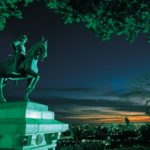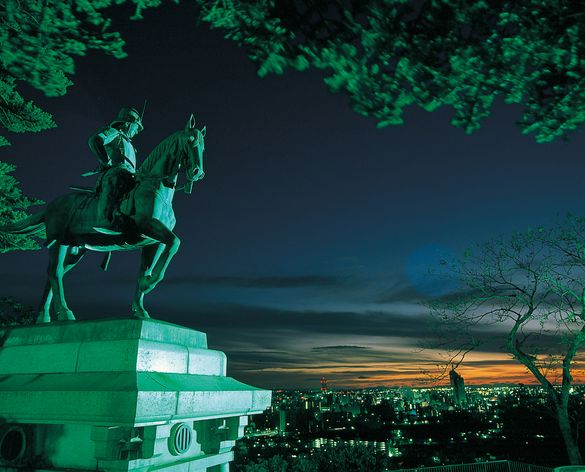 In Japan, there is an initiative known as “Japan Heritage” that aims to acknowledge narratives depicting the culture and traditions of different regions through their historical and distinctive characteristics. The primary goal of the Japan Heritage Program is to rejuvenate local communities by utilizing and sharing a collection of tangible and intangible cultural assets that play a crucial role in narrating these stories.
In Japan, there is an initiative known as “Japan Heritage” that aims to acknowledge narratives depicting the culture and traditions of different regions through their historical and distinctive characteristics. The primary goal of the Japan Heritage Program is to rejuvenate local communities by utilizing and sharing a collection of tangible and intangible cultural assets that play a crucial role in narrating these stories.
We will be introducing some of the narratives and cultural assets related to Date Masamune, a feudal lord who attained local dominance through battles during the Sengoku period and established the Sendai Domain, encompassing the entirety of Miyagi prefecture and parts of Iwate and Fukushima prefectures. The Sendai Domain boasted the third-highest Kokudaka (land value) in the country.
Date Masamune, renowned for his remarkable political and military achievements, was equally celebrated as one of the most cultured men of his era. Creating his own capital, Sendai, he skillfully blended the pinnacle of Momoyama culture with the traditional culture rooted in the Tohoku region. Moreover, he embraced foreign influences, infusing his innovative and stylish sensibilities into an entirely new cultural identity that had never existed before. This novel culture disseminated from Sendai across the nation, permeating both the samurai class and the common people. Even in present times, the term “Date,” derived from Masamune’s surname, continues to be used as a synonym for words meaning “chic,” “stylish,” and “extravagant.” As a result, the “DATE Culture” that originated with Masamune spread, took root, and matured, has garnered recognition as a significant Japan Heritage.
Sendai Castle Ruins, a Reminder of the Glorious and Splendid Past
Sendai Castle Honmaru, situated on a river terrace of the Hirosegawa River at the foothill of Mt. Aoba in the western part of Sendai City, Miyagi Prefecture, is believed to have been constructed by Date Masamune in 1601 as his personal residence. Protected by natural fortifications, with Mt. Aoba to the west, Tatsunokuchi Gorge to the south, and cliffs overlooking the Hirosegawa River to the east, it served as the central stronghold of the Sendai Domain until the Meiji Restoration. While the Honmaru (main enclosure) and other structures were eventually demolished, the stone walls and reconstructed side turrets that stand today serve as a poignant reminder of its historical significance. The area encompassing the castle ruins has been preserved as Aobayama Park, featuring a statue of Masamune on horseback. From this statue’s vantage point, one can enjoy a sweeping panorama of Sendai City and the vast Pacific Ocean, offering a unique opportunity to witness the same breathtaking scenery that Masamune himself once admired.
What type of castle was Sendai Castle? Based on historical records, it was a formidable stronghold fortified with tall stone walls, and the Honmaru served as an opulent palace. There was no castle tower, and Sendai Castle consisted of diverse structures, including the Honmaru Great Hall, which served as the central building, a Kakezukuri (suspended structure) resembling the stage of Kiyomizu-dera Temple in Kyoto, and five turrets for added defense.
Let us examine the “Illustration of Sendai Castle and the Main Buildings of the Edo Kamiyashiki” (Sendaijo Oyobi Edokamiyashiki Shuyotatemono Sugataezu), which is part of the valuable cultural property comprising this group of Japan Heritage, owned by the Sendai City Museum (*Currently closed until the end of March 2024, subject to change). This unique illustration is the sole document showcasing the significant structures of Sendai Castle and Edo residences during the Edo period (1603-1868) in an elevation view. Handed down through generations, it originally belonged to the Senda family, who served as master carpenters for the Sendai Domain during the feudal era. This illustration portrays the main structures of Sendai Castle, including the Honmaru Great Hall, Kakezukuri, Onarimon Gate, and Ninomaru (second enclosure), as well as the main structures of the Edo Kamiyashiki, all drawn to a scale of 1/100. According to this drawing and previous research, it is evident that the Honmaru Great Hall, which was utilized for ceremonies and hosting guests, boasted an opulent and splendid exterior. Constructed in the Shoin-zukuri style, a refined architectural style from the Momoyama period, the Honmaru Great Hall encompassed 14 exquisitely-designed rooms, covering an area of 709.5m².
Today, the grandeur and magnificence of the Honmaru Great Hall can be witnessed through its ornate wall decorations, notably the “Partition Painting of Phoenixes from the Honmaru Great Hall of Sendai Castle” (Sendaijo Honmaru Ohiroma Shohekiga Ho-oh Zu) owned by Matsushima Town. This artwork adorns the Jodan-no-ma (upper room), where the feudal lord would sit within the Honmaru Great Hall. Reflecting the indomitable spirit of Date Masamune, a prominent feudal lord from the Sengoku period, the painting portrays a pair of phoenixes in bold colors against a background of golden clouds and gilded ground. Another notable piece is the “Senmenzu Byobu” (folding screen with fan-shaped paintings, owned by Sendai City Museum), which is a reimagined version of the mural from the Michodai throne. This exquisite work exudes an elegant and refined allure with its fan-shaped depictions of renowned locations and intricate floral patterns, all set on a backdrop adorned with scattered silver foil. In the Honmaru Great Hall, the captivating artworks, enriched with vibrant colors enhanced by gold and silver elements, contribute to the creation of a truly beautiful and opulent palace.
At Sendai Castle Kenbunkan, a facility constructed on the Honmaru site, visitors can experience a complete reconstruction of the “Partition Painting of Phoenixes from the Honmaru Great Hall of Sendai Castle” in full scale. Additionally, they can observe a meticulously crafted 1/50th scale model of the Honmaru Great Hall. This offers visitors a unique opportunity to grasp the immense scale and breathtaking magnificence of the castle.
The Items Used by Date Masamune Exude a Sense of Aesthetics
Date Masamune’s innovative sense of aesthetics extended to his attire and personal belongings. An exemplary representation of this is the “Black Lacquered Armor with Five-Piece Cuirass” (Kuro Urushi Gomai-do Gusoku Owned by Date Masamune). It showcases Masamune’s distinct taste for beauty, as evidenced by the ensemble featuring an iron black lacquered five-panel body, a Sujikabuto (helmet) constructed from 62 iron plates, and a gold-leaf covered Maetate (front ornament) designed with an asymmetrically-shaped crescent moon motif. The Gomai-do (five-panel body), also known as Sendai-do, was handed down through successive lords and vassals, perpetuating Masamune’s unique artistic sensibilities.
The “Yamagata Monyo Jinbaori” (black wool jinbaori surcoat with red mountains motif owned by Date Masamune), designated as an Important Cultural Property, is another of Masamune’s esteemed costumes. This attire features a black broadcloth adorned with intricate gold and silver braid, while the scarlet felt-garnished hem showcases a Yamagata pattern using a delicate technique where seams remain invisible. The collar bears remnants of pleated decorations, subtly integrating elements of the Nanban style that prevailed during the Momoyama period (1573-1603) into various aspects of the garment.
The possessions cherished and utilized by Masamune were laid to rest alongside his body in Zuihoden Mausoleum, his final resting place. During excavations at the site, a smoking pipe, a sword, and a gold brooch, believed to have been crafted overseas, were also discovered.
These costumes and personal belongings are currently housed in the Sendai City Museum and Zuihoden Mausoleum. While the Sendai City Museum is temporarily closed until the end of March 2024 (subject to change) due to extensive renovations, visitors can still view a replica of the “Black Lacquered Armor with Five-Piece Cuirass” at the Sendai Ryokusaikan, a Visitor Center constructed at the base of the Sendai Castle Ruins (open until approximately early March 2024).
Matsushima, a Scenic Spot in Tohoku, Boasts Buildings Associated With Date Masamune
Matsushima, a destination with over 260 islands of varying sizes floating in a tranquil bay, remains a beloved tourist spot in the Tohoku region to this day. Revered as an Utamakura—a place celebrated in classical Japanese poetry—Matsushima has captivated the hearts of people from the capital and beyond. Date Masamune, well-versed in the significance of Utamakura, constructed a temporary residence at this revered site, where he hosted lively gatherings. Masamune’s profound sentiments were passed down to subsequent lords of the domain, who continued to cherish and protect this sacred land of Utamakura. Furthermore, Masamune held great respect for the history and traditions entrenched in the Tohoku region. As the Sendai Domain was situated in the ancient Mutsu Province, he dedicated efforts to revive and rejuvenate the once-thriving historical sites in the area. Thus, Matsushima became the dwelling place for numerous points of interest associated with Masamune and the successive lords of his clan.
Zuiganji Temple stands as the preeminent and iconic symbol of Matsushima. As the most renowned Zen temple in Oshu, it was constructed by Masamune over a span of five years and completed in 1609. The main hall, Kuri (kitchen), and corridors within Zuiganji Temple are designated as National Treasures. The exterior of the main hall boasts a grand and sturdy design, while the interior is adorned with 161 large and small exquisitely painted gold-wall paintings and sculptures. The Tsumakazari (gable ornaments) in the Kuri also showcase the opulent essence of “DATE Culture,” epitomizing the aesthetics of Momoyama-style architecture.
Godaido Hall, originally established as part of Bishamondo in 807, underwent reconstruction in 1604 under Masamune’s orders. It is recognized as the oldest surviving Momoyama-style architecture in the Tohoku region and boasts impressive heroic carvings, including the twelve Chinese zodiac signs adorning the Kaerumata (curved wooden supports) beneath the eaves. Within the hall, a sacred statue of Godai Myoo (Five Great Wisdom Kings), regarded as a hidden Buddha statue, resides and is revealed to the public only once every 33 years when the temple opens its doors.
Kanrantei Tea House, perched on a hill with a panoramic view of Matsushima Bay, was originally erected as a temporary residence for clan lords to rest and stay. It is believed to be one of the buildings from Fushimi Castle, which Masamune acquired from Toyotomi Hideyoshi. Later, it was relocated to the domain residence in Edo (Tokyo) and finally moved to its current location by Date Tadamune, the second lord of the domain. From the interior of Kanrantei, visitors can appreciate the breathtaking beauty of Matsushima while being captivated by the Momoyama-style paintings adorning the Tokonoma (alcove) and Fusuma (sliding doors). These magnificent artworks, painted in vibrant Momoyama-style colors, distinctly epitomize the characteristics of the Momoyama period. Today, Kanrantei is open to the public, allowing visitors to savor matcha while marveling at the breathtaking vista of Matsushima Bay.
The Festivals of Sendai, Passed Down From Masamune to the Common People
The cultural legacy forged by Date Masamune extended its influence to diverse regions, taking root in the lives of present-day Miyagi residents. A notable manifestation of this is the numerous festivals held in various regions.
Osaki Hachimangu Shrine stands as a symbol of the “DATE Culture” fostered by Masamune, and each January, it hosts a special event called the “Matsutaki Festival (Donto-sai).” Since the Edo period, this festival has been a tradition where New Year’s pine decorations, Shimenawa (Shinto straw ropes), and Ofuda (paper talisman) are ceremoniously burned at Osaki Hachimangu Shrine from sunset on January 14 until dawn the next day, during the Koshogatsu holiday. This cherished event has been passed down through generations, evolving into one of Japan’s largest and most significant New Year’s send-off festivals, the Matsutaki Festival. A distinct aspect of the Matsutaki Festival is the Hadakamairi, where men in Sarashi (loincloths) and Zori (straw sandals) pay a visit to the shrine. This practice was initiated by the Toji, master sake brewers, and continues to be a unique and cherished tradition of the festival, and records show that people have been doing this since around 1850.
The Sendai Aoba Festival has its origins in two significant historical events: the Sendai Festival, the grandest festival of the Sendai Domain during the Edo period, and the Aoba Festival, a large-scale celebration dedicated to Date Masamune at Aoba Shrine. After being discontinued for many years, the festival was revived in 1985. For two days each year in May, the festival captivates attendees with a range of activities. The highlights include the procession of the portable shrine of Aoba Shrine, the Period Picture parade, where heroic floats and armored warriors march through the city center, and the Sendai Suzume Odori (sparrow dance) said to have originated from stone masons who assisted in constructing Sendai Castle. Moreover, the festival features demonstrations of old-style firearms and performances of the Sendai fire-fighting tradition known as Hashigo-nori (acrobatic performances on a ladder), all set amidst the vibrant greenery and bustling streets filled with enthusiastic crowds.
The “Sendai Tanabata Festival” is an annual event held from August 6 to 8. Rooted in a Chinese ritual where women prayed for the advancement of their handicrafts and skills, the Tanabata celebration was already embraced by the Sendai Domain during Masamune’s time, as evidenced by his composition of eight classical Japanese poems about Tanabata. Over the years, the traditional Sasatake (bamboo stalks) adorned with strips of paper carrying wishes for improved craftsmanship evolved into a more extravagant display, thanks to the involvement of merchant families. In the modern Sendai Tanabata Festival, the central shopping street comes alive with magnificent decorations of giant bamboo, measuring over 10 meters in length, skillfully crafted using Japanese paper. Visitors can enjoy the magical atmosphere of the festival by strolling amidst the vibrant and fluttering bamboo decorations.
Traditional Crafts Handed Down From Generation to Generation
In addition to festivals, the culture nurtured by Masamune extended its influence to diverse individuals, including the townspeople and craftsmen residing near Sendai Castle. Among the cultural contributions, crafts made by skilled artisans serving the Sendai Domain stand out. These traditional crafts have withstood the test of time and continue to be cherished as souvenirs.
Tsutsumiyaki takes its name from the kiln located in Tsutsumi-machi, Aoba-ku, Sendai, which still bears the same name today. This pottery style is known for its simple yet powerful appearance, featuring a sea cucumber-colored glaze with bold pours of black and white glazes over the pottery. Originally, the tea utensils created in this style were cherished as gifts for the Date family and their vassals, as well as offerings to feudal lords and court nobles. Over time, they gradually became everyday utensils used by the general public. Today, the Kenba kiln remains the sole surviving kiln, continuing to produce mugs, Guinomi sake cups, rice bowls, and other dishes that have become an integral part of daily life.
Tsutsumi dolls are believed to have originated from the art of Tsutsumiyaki. These dolls are characterized by their opulent three-dimensional design, drawing inspiration from the popular Ukiyo-e prints of that era. Alongside Kyoto’s Fushimi dolls, they were regarded as the primary sources of clay dolls and stood at the pinnacle of local clay doll craftsmanship. Even today, using traditional clay molds and materials passed down through generations, skilled craftsmen continue to create Ukiyo-e style dolls, seasonal decorations, hina dolls (Girl’s Festival decorations), adorable animal figures, and various other items.
The origin of Sendai Hariko (papier mache) is attributed to Toyonoshin Matsukawa, a samurai serving the Sendai Domain. The prominent type of Sendai Hariko is the Matsukawa Daruma, famously known as the Blue Daruma. While most Daruma dolls are typically red, the Matsukawa Daruma features an ultramarine blue border around the face and includes a treasure ship or Fukunokami (god of fortune) depicted on its body. These vividly colored Daruma dolls have been cherished by the people of Sendai as a symbol of good luck. Additionally, craftsmen also produce black masks and other papier mache toys.
Sendai Tansu, or portable storage chests, have been nurtured by skilled craftsmen who congregated in the castle town of the Sendai Domain since the end of the Edo period. These chests are predominantly crafted from zelkova wood, adorned with a vibrant and transparent red Kijironuri lacquer finish, and embellished with hand-hammered metal fittings featuring patterns like peonies and Chinese lions. Three adept artisans, specialized in cabinetry, lacquer painting, and metalwork, collaboratively produce Sendai Tansu. Their creations are distinguished by their chic and extravagant designs, epitomizing the essence of the “DATE Culture.”
Sendai, a City Where the Legacy of Masamune Lives On
The achievements of Date Masamune, the founder of the Sendai Domain, in establishing the city of Sendai and fostering a rich culture in the area are immeasurable. When visiting Sendai, one will witness that even after more than 420 years since the inception of the Sendai Domain, the legacy of “Date” that Masamune left behind still prevails in different aspects of the city.



















